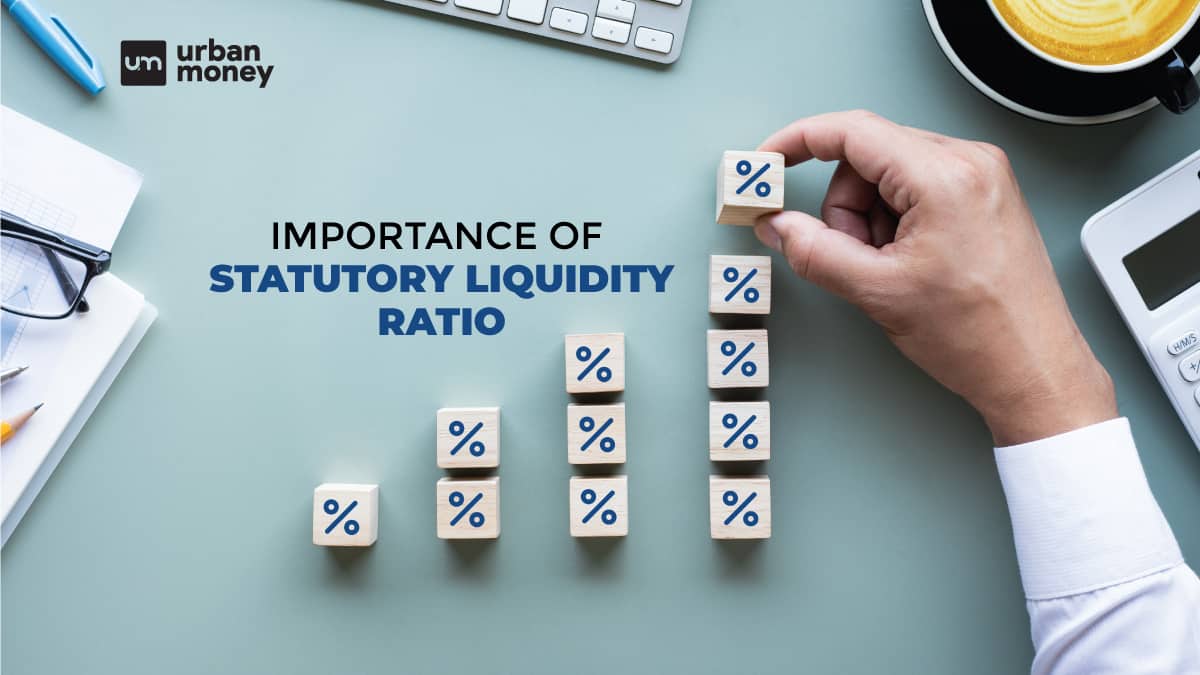Top 10 Best Private Banks in India List 2025
January 09, 2025
Personal Loan Archive | Statutory Liquidity Ratio

October 04, 2022


The economy of every country majorly depends on banks and hence, each country has a monetary authority that regulates how banks operate. In India, we have the Reserve Bank of India (RBI) as our principal monetary regulator operating at a national level. But the question is – how does this relate to the Statutory Liquidity Ratio (SLR)?
One of the primary functions of the RBI is to regulate the supply of credit as well as its cost. As per RBI rules, every bank must hold a specific liquid reserve, which could be in the form of cash or gold. The ratio of these liquid assets is known as the Statutory Liquidity Ratio. The term statutory means it is obligatory and legally important.
In this article, we will take a deeper look into the statutory liquidity ratio meaning, how SLR works with banks, SLR objectives, and more.
Table of Contents
ToggleStatutory Liquidity Ratio can be defined as the minimum percentage of deposits maintained by commercial banks in the form of cash, gold, and other securities. The Statutory Liquidity Ratio is popularly known as SLR. The RBI doesn’t interfere in the deposits maintained by the banks as it’s completely up to the bank in which form it wants to hold the deposits.
Currently, the statutory liquidity ratio in India is 18%.
If any bank fails to maintain the SLR at a certain specified level, they will be liable to pay a penalty to the Reserve Bank of India. On the deficit amount on that specific day, the defaulter bank has to pay penal interest at a rate of 3% per annum above the base rate. If the defaulter bank continues the default, the penal interest rate will be increased to 5% per annum over the bank rate.
The Department of Banking Operations and Development of the Reserve Bank of India has issued a public circular regarding the same.
The statutory liquidity ratio is a type of ratio that every bank is obligated by the RBI to maintain. The other reserve ratio is the Cash Reserve Ratio (CRR).
A CRR is defined as a specific percentage of a bank’s overall deposits that must be kept with the RBI as a cash reserve. According to the specifications of the RBI, a bank must maintain both SLR and CRR to ensure it functions effectively in India.
RBI gives customised instructions to each banking institution about the maintenance of SLR. Moreover, RBI also delivers regular updates about the classification of assets that will be treated as liquid assets under SLR.
The RBI was introduced by the Government of India as a measure to ensure the proper functioning and regulation of banks in the country. The Reserve Bank of India works on a central level. The RBI takes measures to ensure that prices always remain stable in the country without heavy fluctuations.
The Reserve Bank of India is mainly responsible for creating and operating a monetary policy that helps in nursing the supply and flow of money to attain better growth in the economy. This is achieved through managing and monitoring various interest rates.
This is done by implementing a set of monetary policy instruments such as cash reserve ratio, statutory liquidity ratio, credit ceiling, open market operations, bank rate policy, repo rate, reverse repo rate, credit authorisation scheme, moral suasion, etc.
Each of these instruments are crucial to managing, controlling, and coordinating the flow of money in the country’s economy.
Given below are the objectives of monetary policies formed by the Reserve Bank of India:
In India, every scheduled commercial bank, non-scheduled commercial bank, state and central cooperative banks, and primary (urban) co-operative banks are compulsorily required to keep a statutory liquidity ratio.
Every bank has a specific portion of its Net Demand and Time Liabilities (NDTL) in the form of gold, cash, or other liquid assets by the day’s end. The ratio of such liquid assets to the demand and time liabilities is referred to as the Statutory Liquidity Ratio (SLR). The RBI holds the power to increase the SLR by up to 40%.
If the SLR increases, it boosts the bank’s ability to inject money into the economy. RBI also regulates the flow of cash and the stability of prices to run the economy of India. The SLR is one of its various monetary policies for the same. The statutory liquidity ratio along with some other tools ensures the cash flow and solvency of the banks in the economy.
Every bank is obligated to furnish an update or a report to the Reserve Bank of India every alternate Friday pertaining to their SLR status. In case any bank fails to maintain the specified SLR, it will have to pay certain penalties.
The minimum limit of SLR in India is 0, while the highest limit is 40%.
With an increase in SLR, banks become restricted in the context of their leverage position. Therefore, this rise in the SLR allows the bank to release more into the economy, which in turn, contributes to the overall development of the country’s economy.
The RBI regularly reduces the statutory liquidity ratio of the banks in India. Given below are some of the reasons they do so:
Based on the prevailing situations in the nation and across the globe, a reduction in the SLR rate will help in achieving financial stability. In today’s ever-fluctuating financial atmosphere that sees constant change and alterations, financial stability is highly crucial.
The current SLR (Statutory Liquidity Ratio) in India is 18%, which was cut in 2018 to free up ₹ 1-1.5 trillion of funds in the next one and half years into the banking system.
All banks operate on some kind of risk. Each bank has a specific component known as risk capital. This is basically the capital promised by the owners of any bank.
The risk capital acts as an excellent buffer against risk that banks take. When a bank operates on too much risk, it becomes highly crucial for them to treat the risk capital very cautiously. Therefore, one can clearly determine that the correct SLR level would be the level of risk capital of any bank.
To ensure that the bank’s risk capital is entirely secure, the bank must maintain its risk capital as the statutory liquidity ratio.
The most fundamental rationale for why RBI laid the SLR is wariness. In any financial activity, it is crucial to be wary and cautious. All the banks in the world operate with a primary code to collect deposits from the public and then assure them with funds at par or more.
Nevertheless, the action is quite risky for every bank. Therefore, to protect the risk and reduce their risk rate, the Reserve Bank of India has mandated every bank in the country to deploy at least one small proportion of its fund with the RBI. This money will be kept safe in the hands of the most secure entity in the form of the most secure assets. This is where the role of SLR comes into play.
The Statutory Liquidity Ratio helps in improving the economy. It is an incredible direct monetary tool that has helped the Indian government in selling its debt instruments and securities to banks from time to time. It has encouraged and boosted the government’s debt management programme, which is designed to help banks render first-class loans to every sector in India.
The SLR also works toward reducing the commercial banks’ holdings in government securities and gradually progressing towards private security holdings. The securities related to SLR are securities that are risk-free.
One of the biggest functions of SLR is to preserve the minimum rate also known as the base rate at which Indian lenders lend money to their customers. SLR plays a crucial role in creating transparency between the Reserve Bank of India and other banks in the country. Only the RBI has the authority to decide and fix the SLR ratio.
The functioning of the SLR has been specified in Section 24 and Section 26 of the Banking Regulation Act of 1949. The Act states that all commercial banks operating in the country are obligated to maintain the ratio. Hence, it is imperative to know about the component of the statutory liquidity ratio in order to understand accurately how the SLR works. Given below are some of the major components of the SLR:
Liquid assets can be defined as bank-held assets that can be easily converted into cash by banks in 1-2 days. Assets like treasury bills, gold, cash reserves, government bonds, and government-approved securities are liquid assets that can be easily converted to cash. Securities eligible under the Market Borrowing Programme and Market Stabilisation Scheme (MSS) are also considered to be liquid assets.
Net demand is defined as the bank’s potential to withdraw money from its account immediately. However, time liabilities refer to the time period for which the bank has to stay on hold to redeem its liabilities.
Net demand and time liabilities together represent the total demand and liabilities in deposits that are held by public banks.. Demand Deposit is all the liabilities that a bank is obligated to pay on demand. Such deposits may consist of current deposits, demand drafts, balances in overdue fixed deposits and demand liabilities portion of savings bank deposits.
On the other hand, time deposits comprise deposits that must be repaid on maturity or where the depositor can’t withdraw the amount immediately. Hence, the applicants are supposed to wait for the expiry of their lock-in period in order to be eligible to access the funds.
Staff security deposits, fixed deposits, and the time liabilities portion of savings bank deposits are a few examples of time deposits. The liabilities of a bank include call money market borrowings, investment deposits, and a certificate of deposits in other banks.
You can calculator Statutory Liquidity Ratio using the following mathematical formula:
SLR = (liquid assets / (demand + time liabilities)) * 100%.
Let us understand it with the help of an illustration.
Suppose there’s a bank named XYZ. It has liquid assets (LA) worth ₹ 3 crore. The bank possesses ₹ 25 crore in Net Time and Demand Liabilities (NTDLs). To determine the SLA of XYZ Bank with the aforementioned assets, we will use the formula as follows:
Statutory Liquidity Ratio (SLA) = LA/NTDL
SLA = (3/25) x 100
Statutory Liquidity Ratio = 12%.
Hence, the bank’s SLR ratio is 12%.
Before we discuss how SLR influences the base rate, let us first glance through the definition of the base rate.
The base rate refers to the minimum lending rate of a bank. The Reserve Bank of India has fixed the base rate to ensure the transparency of the credit market in terms of lending and borrowing. No bank or financial institution can fund/offer a loan at a rate lower than the base rate.
The SLR has a major role in determining the base rate of the Indian economy. This is precisely why the RBI and the government of India work together to ensure that the statutory liquidity ratio is balanced.
The RBI regularly monitors the SLR so that banks have higher leverage and a better influence. The RBI also scrutinizes how banks look into their funds’ availability for accepting deposits from customers and providing credits to customers.
SLR and CRR are the two most important components of monetary policy that must be maintained by all banks in India to ensure they function effectively. Still, both SLR and CRR differ from each other on various grounds as follows:
| Statutory Liquidity Ratio (SLR) | Cash Reserve Ratio (CRR) |
| In SLR, the RBI asks banks to reserve liquid assets in the form of Cash or Gold. | The CRR requires banks to have only cash reserves with the Reserve Bank of India. |
| SLR is usually applied to control the bank’s leverage for credit expansion. | The Central Bank regulates the liquidity in the banking system with CRR. |
| In SLR, the banks themselves keep the securities, which they must maintain in the form of liquid assets such as Cash and Gold. | In the case of CRR, the banks maintain the cash reserve with the RBI. |
| Banks can gain returns on money reserved as a Statutory Liquidity Ratio. | Banks don’t earn returns on money reserved as CRR. |










© 2025 www.urbanmoney.com. All rights reserved.

Need Loan Assistance?

















